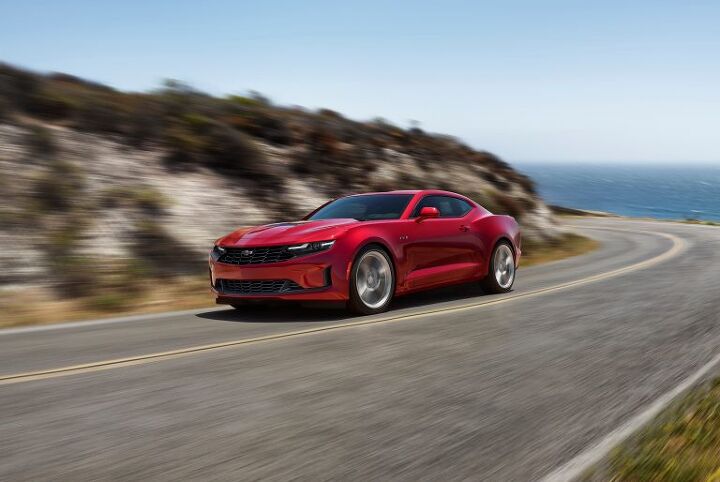Problem Solved? 2020 Chevrolet Camaro SS Dons New Face, Placating an Outraged Public

It was something we bitched and moaned about to no end in these digital pages. While most iterations of the refreshed 2019 Chevrolet Camaro looked, well, fresh, the popular SS model clearly fell on its face sometime before leaving the factory.
By blacking out the grille’s thick horizontal crossbar and migrating the bowtie emblem from the upper opening to a central position, Chevy designers greatly increased the face’s visual height. The resulting Camaro SS looked somewhat ill; its chiselled, Brad Pitt-like visage contorted into a Karl Malden-esque countenance.
It looks like rumors of an emergency refresh were 100 percent true, as the 2020 model, seen above, has emerged from under the knife with a new nose. For the upcoming model year, Chevy also wants to get you into a V8 for less cash.
Both your author and Matthew Guy griped about the SS’s “derpy” face (his words, not mine), which looked awful next to the clean look of, say, the 1LE. (See the 2019 SS below.) The SEMA show car revealed shortly after the 2019 model’s introduction, as well as Chevy’s NASCAR Xfinity Series entry, hinted that the automaker was having sudden second thoughts about the model’s appearance.
Mr. Guy suggested his own fix, which placed the Chevy emblem back up where it belongs. The company went one further, making the fat crossbar body-colored, further reducing visual height.
Indeed, Chevrolet is willing to (tacitly) admit it made a mistake.
“Customers spoke, and we listened,” said Steve Majoros, director of Chevrolet passenger car and crossover marketing, in a statement. “The overwhelmingly positive reaction to the Shock’s stylized design helped prompt its transition from concept to production.”
Changes to the Camaro line don’t end with the SS, as there’s a sales slide to arrest. For the upcoming model year, Chevy is adding an LT1 trim to the roster, which can only indicate the presence of a GM V8 engine. In this case, a 455-horsepower, 6.2-liter eight-cylinder borrowed from the SS and dropped into a model positioned between the LT and SS.
After-destination sticker price for the LT1 is $34,995, three grand below a base 2019 SS, with buyers offered a choice of six-speed manual or 10-speed automatic transmission. Coupe and convertible bodystyles are available.
Elsewhere, content changes abound, with the V6-powered LT models gaining a 10-speed auto (tailored for V6 performance, Chevy claims). All models can be had with Rally Green paint, red seatbelts and kneepads, and alloy pedals, while LS and LT models can be optioned out with rear spoilers and tinted tail lamps. Twenty-inch wheels and a choice of red or orange brake calipers appear on the LT, LT1, and SS option lists. Recaro performance seats migrate from the 1LE to the LT, as well.
The (V6) 3LT trim added for 2019 can now be had with the 2.0-liter turbo four and Chevy’s Convenience and Lighting package.
All of these changes come as General Motors attempt to reverse the pony car’s falling sales. Last year saw Camaro sales fall 25 percent, though the first quarter of 2019 showed the model up 2.5 percent. Offering more for less is a time-honored ploy to populate showrooms, and so is undercutting your competition. A base 2019 Ford Mustang GT coupe stickers for $36,350 after destination, placing the cheaper Camaro V8 in good standing. However, an existing cash incentive pushes the base Mustang V8’s price $45 lower than that of the 2020 Camaro LT1.
Pricing for the full Camaro line should come into focus before the 2020 model goes on sale this fall.
[Images: General Motors]

More by Steph Willems
Latest Car Reviews
Read moreLatest Product Reviews
Read moreRecent Comments
- SilverCoupe Tim, you don't always watch F1 as you don't want to lose sleep? But these races are great for putting one to sleep!I kid (sort of). I DVR them, I watch them, I fast forward a lot. It was great to see Lando win one, I've been a fan of McLaren since their heyday in CanAm in the late '60's.
- Cprescott The problem with this fable by the FTC is:(1) shipping of all kinds was hindered at ports because of COVID related issues;(2) The President shafted the Saudis by insulting them with a fist bump that torqued them off to no end;(3) Saudis announced unilateral production cuts repeatedly during this President's tenure even as he begged to get them to produce more;(4) We were told that we had record domestic production so that would have lowered prices due to increased supply(5) The President emptied the strategic petroleum reserve to the lowest point since the 1980's due to number 3 and then sold much of that to China.We have repeatedly been told that documents and emails are Russian disinformation so why now are we to believe this?
- Ollicat Another Biden attempt to say, "Look over there!"
- Kjhkjlhkjhkljh kljhjkhjklhkjh Who cares. Price of gas is not the issue. spending an extra 100$ a month over 4 tanks of gas is not the issue.this a political scam to distract really dumb people from the real issue. if rent and house payments were not up by 50% to as high as 150% higher in a ton of locations, then paying an extra 100$ in gas would be annoying but not really an issue. But the real-estate market with hedge fund investors, power-relator groups bought a ton of houses and flipped them into rentals and jacked up the rates uplifting the costs on everything else. and ironically no-one seems to be in any hurry to build more houses to bring those costs down because supply and demand means keeping less houses available to charge as much as you want. It is also not the issue as a secondary issue is child care costs and medical... again 100$ extra per month in gas is *nothing* compared to 800$ a month in ''child care'' and 300$ per visit to the doctor office, 300$ for a procedure less dentist trip..
- Ajla Is there something proprietary or installed on the moon with these that I'm not aware of?



































Comments
Join the conversation
Looks fantastic. Glad they made the change.
Still hoping for Chevy to install windows in the Camaro...